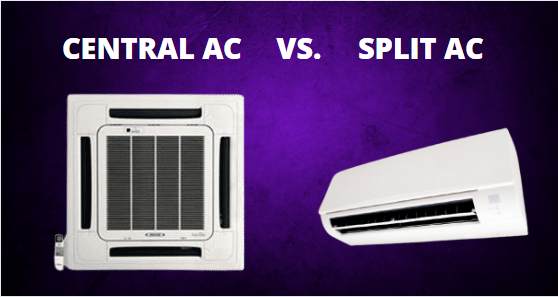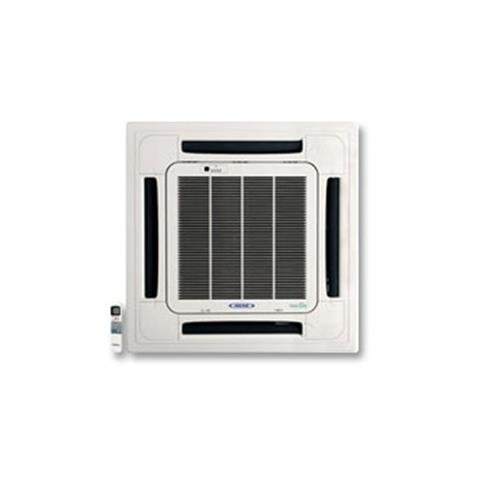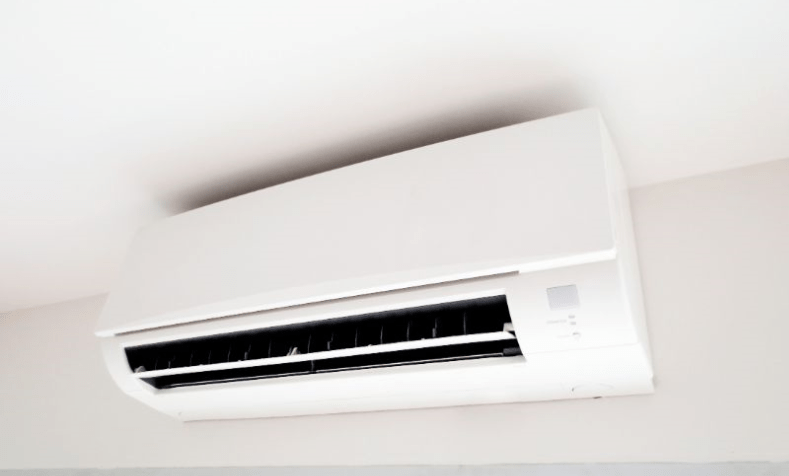When purchasing an air-conditioner, Central AC Vs Split AC can get confusing. An air conditioner is an important part of our lives. This home appliance has grown with us and has undergone innovation according to the changing times. This appliance has grown from a basic cooling device to a more sophisticated device with multi-functional applications. Other functions like dehumidifying the incoming air, ventilation, as a basic fan when required, and a chilling device. With the growing demand, air conditioners have evolved to be energy-saving devices as well. On the flip-side, with the increasing development of numerous designs and models, the users can get confused.

Depending upon the function and application, the air conditioners are of six major types. These are specifically designed for certain spaces and purposes. These are of the following types:
- Central Air Conditioner
- Windows Air Conditioner
- Ductless Mini-Split
- Floor Mount Air conditioner
- Portable Air conditioner
- Smart Air Conditioner
- Hybrid/Dual fuel Air Conditioner
- Geothermal Air Conditioner
The popularity of the various air-conditioner types depends upon the four important factors:
- The Energy consumption
- Budget
- Cooling power
- Space requirement and Maintenance
Working Of A Basic Air Conditioner(AC)
Before we understand the air-conditioner type required, it is essential to know the working of the basic air-conditioner. So, how does an air-conditioner works:
PRINCIPLE: A device that works by collecting the hot air from a certain space and converting it into cool air, and releasing it into the same space.
WORKING: An Air Conditioner is divided into four parts:
- The Evaporator: This is a coil that functions as a heat exchanger. It is here that the liquid refrigerant absorbs the heat and evaporates into a gaseous state.
- Compressor: This part functions by compressing the gaseous refrigerant. It is usually located outside the house.
- Condenser: The vaporized refrigerant arrives from the Compressor to the Condenser. Here the refrigerant is converted back into the liquid state, and the heat is released in the process outside.
- Expansion Valve: This is a valve that is located between the two sets of coils. This functions as a control on the quantity of the refrigerant that travels towards the evaporator
- Refrigerant: This is a Chemical compound that functions as a carrier of heat in an Air conditioner device. It changes from liquid and back into gas in the refrigerant cycle.
How Air Conditioner(AC) Works?
As soon as the Air conditioner is switched on, the device senses the difference in the temperature of the room and the desired temperature. The Hot air is ‘sucked-in’ through the indoor unit set-up and is flown over the pipes which contain the refrigerant. This way, the heat is absorbed by the refrigerant liquid and converts into a gas. This way, the heat is absorbed from the air as it flows through the evaporator coil. This heated-up air is allowed to flow through the Compressor. The gas is then compressed, thus increasing its temperature. The high-pressure gas is then allowed to flow through the Condenser. Here, the hot gas condenses into a liquid state. As the liquid is released from the Condenser is grows into a cool liquid. This is later allowed to flow through the Expansion valve, which is known to cool the flow of the liquid refrigerant into the evaporator. This cycle is continued in a manner so that the required temperature is achieved.
What is Central AC?

The Central Air Conditioning comprises an energy-efficient cooling system that allows cooling the entire structure from a central location. This system is programmed to dehumidify the air and cool the air throughout the building. When it comes to Central Ac Vs Split AC, one must bear in mind that the Split AC is effective in cooling just a single room, while the Central AC can cool the entire building. The main components of the Central AC are:
- Fans: to pull the air within the system.
- The Evaporator Coils: Used to convert the refrigerant from the Liquid state to gas state.
- Compressor: Used to pressurize the Refrigerant gas.
- The Condenser Coil: Used to convert the Refrigerant gas into Liquid.
- The Refrigerant Lines: that is used to carry the refrigerant across the Coils.
- The Expansion Device: This is used to regulate the refrigerant flow into the evaporator.
What is Split AC?

In this Air Conditioner type, the system is divided into two Components:
The Outdoor: This comprises the Condenser, Expansion Valve, and Compressor. As the name suggests, this unit is placed outside of the home.
The Indoor: This usually comprises the Evaporator coil and is placed inside the house. This works as an air handler.
Both the units are connected through refrigerant lines that function by conducting the refrigerant back and forth in between the two units.
What is the Difference Between Central AC and Split AC?
So, when going for an air conditioning system for your home, what can you go for. To better understand, let us take a look at the differences between the two:
CENTRAL AC | SPLIT AC |
This comprises a single unit located within the home that controls the cooling across the entire building | Comprises of two different units: the Outdoor unit, the Indoor Unit |
Is perfect for a large establishment | Is preferred for a small home or a room |
Needs professional help for installment | Is comparatively easier to install |
Is not visible, and does not obstruct the view across the room. | Is within clear view of the room. |
Cannot be tested if the weather conditions do not warrant the operations | Can be tested for the same |
Has a silent operation | Is noisy in comparison |
High on maintenance | Is easier to maintain in comparison |
Will operate even in rooms that are rarely used | Is specific to the room it is installed in |
Needs Ductwork | No ductwork required |
Is cost-efficient when it comes to not allowing any cool air to escape | Is not as efficient when it comes to cool air escaping |
Is recommended when it comes to people dealing with Allergies | Does not improve air quality |
The Conclusion- Which one You Should Buy?
It is important to select your Air-conditioner according to your need carefully. To understand the air-conditioner type according to your area-size, you need to know the following measurements:
Seasonal Energy Efficiency Ratio(SEER): This is the measurement of the cooling output during the cold season. In a way, the higher the SEER more efficient is the Air Conditioner.
Energy Efficiency Ratio (EER): This is the measurement of the energy used per square foot of cooling. This needs to be considered when selecting various cooling options.
Energy Star Rating: This is an important aspect when selecting an air-cooling option. Higher the Energy star rating better is the energy-saving efficiency. Research shows that costs can be bought down by 30% when taking into consideration the energy star reference.
When Dealing With Large Spaces: It is a no-brainer that a central Air-conditioner is recommended when it comes to large spaces. So, if you have an entire building-like establishment or an office space, a central air-conditioner is preferred. Despite the initial choices of installation, it helps in being more cost-effective when it comes to maintaining the bills.
When Dealing With Limited Spaces: Of course, when it comes to your regular mid-sized home, a Split Air conditioner is a perfect choice. It helps in zonal cooling and can be turned off without affecting the cooling in other rooms. Also, a split AC is perfect when you require the cooling option in a specific space only.
Also Read:
- What Is The Best Temperature For AC in Summers?
- Can an Air Conditioner(AC) Run on an Inverter?
- Gold Fin Vs. Blue Fin Condenser Coils in AC- Which Works Better?
- Split AC Vs. Window AC- Which One Should I Buy?
- Copper Coil Vs. Aluminium Coil in AC-Which Works Better?
- Reciprocating Vs Rotary- Air Conditioner(AC) Compressor-which one is Better?
- The Most Common Reasons For AC Not Cooling